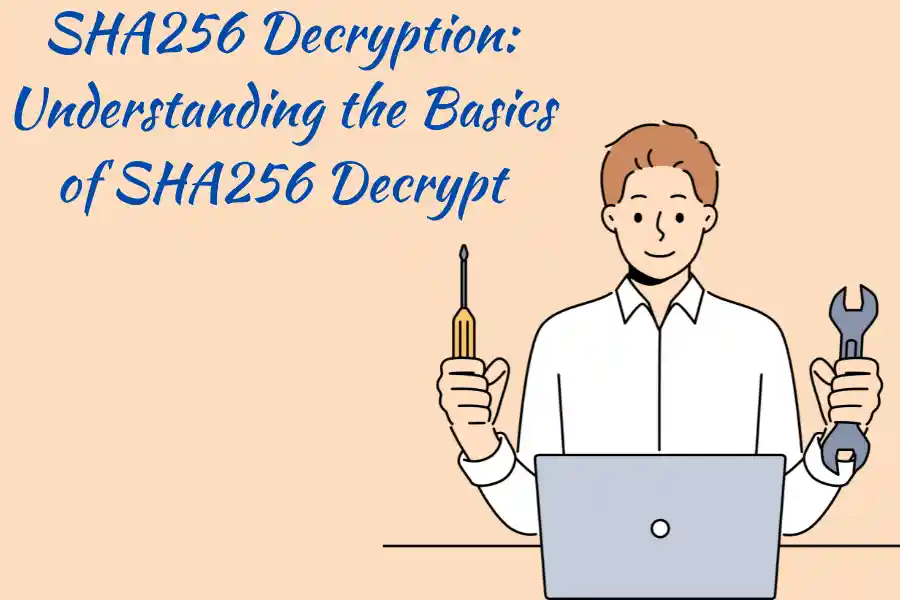SHA256, a cornerstone of cryptographic protocols, plays a vital role in digital security. It forges a unique 256-bit hash value for any input data, rendering it nearly impervious to reverse engineering. In essence, SHA256 operates as a one-way function, impeding decryption. In this blog post, we’ll delve into the essentials of SHA256 decrypt, exploring its inner workings and applications in cybersecurity, particularly its role in bolstering network security. Our primary focus lies in comprehending the foundational principles of SHA256 decryption and its pivotal role in safeguarding sensitive information.
Look for further insights into SHA256 decrypt and its broader applications in the cybersecurity landscape.
What is SHA256 decryption?
SHA256 is a cryptographic hash function that transforms input data into a fixed-size output called a hash. This process is intentionally one-way, making it extremely challenging to reverse and recover the original input. While direct decryption of a SHA256 decrypt is infeasible, attackers may employ brute-force attacks, attempting every possible information. This can be time-consuming, especially for lengthy data. Rainbow tables, pre-computed hashes for standard inputs, offer a shortcut for attackers. Collision attacks, finding different inputs producing the same hash, exploit the function’s properties. Despite these methods, SHA256 remains widely trusted for applications like password storage, digital signatures, and file integrity verification, attesting to its robust security.
How SHA256 Decrypt? Guide
Decrypting SHA-256 is not feasible due to its one-way nature, making it computationally challenging to reverse the hash function and retrieve the original input. SHA256 employs a complex mathematical algorithm to generate a fixed-size hash from any information, making collisions (two different inputs producing the same hash) exceptionally difficult to find. While techniques like rainbow tables and collision attacks can potentially expedite decryption attempts, they are still formidable tasks. It’s crucial to note that attempting to decrypt SHA256 goes against its intended purpose and is not recommended. Instead, seek appropriate solutions within legal and ethical boundaries, such as utilizing encryption keys or password recovery mechanisms.
Role of SHA256 in Securing Sensitive Data
SHA256 is instrumental in securing sensitive data:
Data Integrity Verification: It generates a hash to ensure the data hasn’t been tampered with during storage or transit. For example, before uploading a file to a cloud service, SHA256 creates a hash. Verifying it upon download ensures file integrity.
Password Storage: It’s widely used to store passwords securely. User passwords are hashed before being held, making it challenging for attackers to decipher.
Digital Signatures: SHA256 creates digital signatures for message authenticity. It hashes the content, encrypts the hash with the signer’s private key, and attaches the signature. Recipients verify the soup with the public key.
Blockchain: SHA256 assigns a unique identifier (hash) to each block, ensuring cryptographic integrity.
In summary, SHA256 is pivotal in data security, ensuring integrity, authenticity, and confidentiality across various critical applications. Its impact is felt in password protection, secure communication, file integrity checks, and more, making it an indispensable tool in digital security.
Why is SHA256 decryption impossible?
SHA256 decryption is like solving a very tough puzzle. It’s designed to be extremely hard to figure out the original picture from the pieces. There are two main reasons why it’s so complicated:
First, it’s like finding two very different keys that fit the same lock, which rarely happens with SHA256.
Second, it’s like guessing a secret code, but even with lots of guesses, it’s still really tough. SHA256 is one of the most vital ways to keep things safe in the computer world. It’s used for keeping passwords safe, making sure documents are actual, and checking if files have been changed.
Common misconceptions about SHA256 decryption
Common misconceptions about SHA256 decryption stem from misunderstandings of its security features. One myth suggests that with enough computing power, SHA256 can be decrypted. In reality, it’s designed to resist powerful brute-force attacks; the only way to solve it is by knowing the original input. Claims of secret techniques to decrypt SHA256 are likely scams. Some think SHA256 is insecure due to potential collisions, but this doesn’t compromise security. It’s still tough to find the original input. SHA256 is versatile and used in digital signatures, file integrity verification, blockchain, and more. Despite new vulnerabilities, they aren’t currently seen as practical threats, affirming SHA256’s status as a highly secure hash function.
Best Practices for Utilizing SHA256 Decrypt
SHA256 is a one-way hash function, making decryption impossible. However, here are the best practices for secure usage:
Strong Passwords and Secrets: Use robust passwords or secrets to increase resistance against brute-force attacks.
Secure Storage of Hashes: Keep SHA256 hashes in encrypted databases or password managers for added protection.
Combine with Additional Measures: Employ techniques like salting and password hashing alongside SHA256 for enhanced security.
Keep Systems Updated: Regularly update systems with the latest security patches and improvements.
Implement Multi-Factor Authentication (MFA): Add an extra layer of security with MFA.
User Education: Educate users on password hygiene and recognizing phishing attempts.
Monitor and Audit: Monitor logs for signs of suspicious activity.
Conduct Security Assessments: Regularly test for vulnerabilities and weaknesses.
Strong Key Management: Secure storage and management of cryptographic keys.
Use Secure Communication Protocols: Employ HTTPS for safe data transmission.
Remember, these practices enhance overall security but do not enable SHA256 decryption. They contribute to a comprehensive security strategy for safeguarding sensitive data and ensuring its integrity.
What is the difference between SHA256 and SHA1?
SHA1 and SHA256, both cryptographic hash functions, yield distinct hash values for input data. Notably, SHA1 produces a 160-bit hash, whereas SHA256 yields a more robust 256-bit result. The latter boasts enhanced security, warding off collision attacks more effectively. Although SHA1 is swifter, its compromised security deems it unfit for contemporary applications. Consequently, SHA256 emerges as the favored choice for modern digital security, ensuring more extended and resilient hash values impervious to collision vulnerabilities.
Is there any hope for SHA-256 decryption in the future?
While there is a potential future threat to SHA256 from quantum computers, they lack the practical power to decrypt it. Ongoing research aims to develop new algorithms, but they are still in the early stages, and their success is uncertain. To mitigate this future risk, using more extended and complex passwords, employing multiple layers of security like password managers, and exploring post-quantum cryptography, designed to withstand quantum attacks, can enhance protection against potential decryption threats.
Conclusion
In summary, SHA256 is a potent one-way hash function that safeguards data through irreversible hash generation. Misconceptions have been clarified, emphasizing its resistance to decryption. Best practices include strong passwords, secure hash storage, and layered security. While potential future threats exist, they are not currently practical concerns. To bolster security, adopting post-quantum cryptography and employing multi-layered strategies are recommended. Understanding SHA256 decrypt and its limitations is crucial for its practical and secure application.
If you want to learn more, visit our website, informationalnews.com.

Hi, I’m Ryan! I’ve been blogging, writing, and doing SEO and marketing for over 5 years. I love creating interesting content and making sure people can find it easily on the internet. I’m also really good at coming up with cool marketing ideas to get people excited about stuff. When I’m not working, I enjoy playing with new tech stuff and exploring the outdoors for new ideas. Let’s make awesome things happen together!




One thought on “SHA256 Decryption: Understanding the Basics of SHA256 Decrypt”